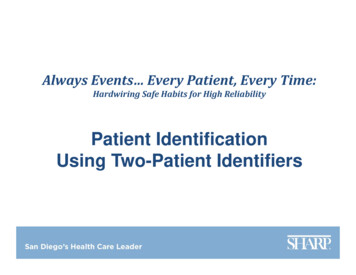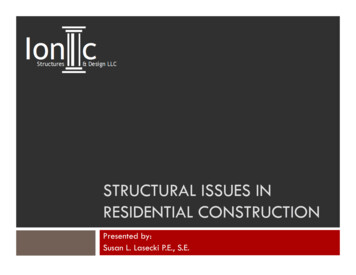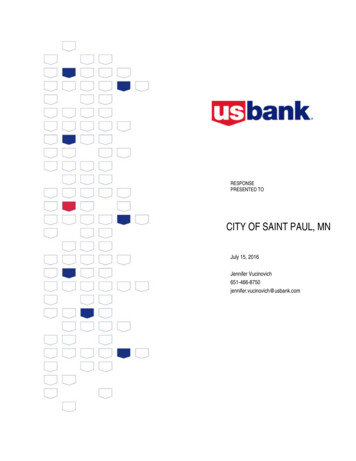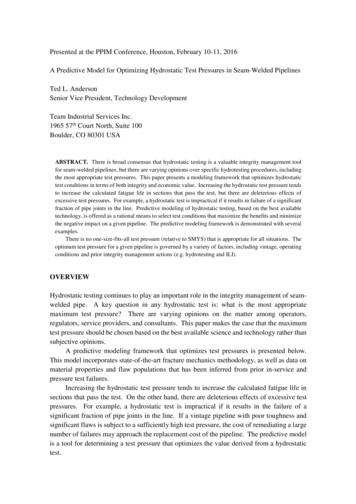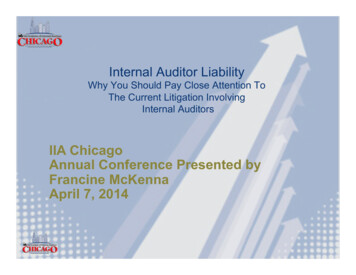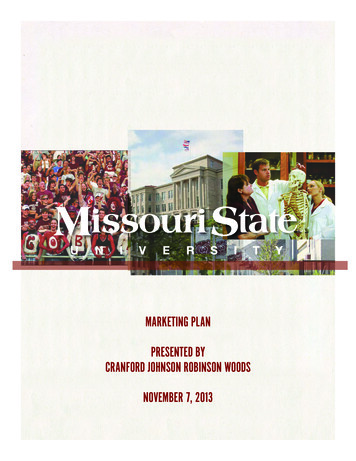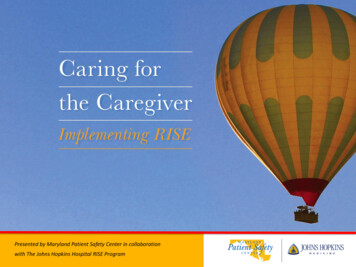
Transcription
Presented by Maryland Patient Safety Center in collaborationwith The Johns Hopkins Hospital RISE Program
Objectives Create the urgency to implement a peersupport program Describe the value of peer support andelements of peer support program Discuss the assessment, implementation andsustainment of an internal peer supportprogram
Armstrong Institute for Patient Safety and Quality
Definition(First Victims: Patients and loved ones)Second Victims: “Health care providers who are involved with apatient-related adverse event or medical error, and as a result,experience emotional and sometimes physical distress”Second Victims often: Feel personally responsible for the outcome Feel as though they have failed the patient Question their knowledge and competence
Stressed /UnsupportedStaffStressedinstitution /leadershipDissatisfied(possibly injured)pts, employeesLow morale /high turnoverPoor pt. care /unsafe careenvironment
Do you want this person taking careof you?
Cost To replace a nurse ranges from 22,000 tomore than 64,000 (RWJF, 2009) To replace a physician ranges from 500,000 to 630,000 considering recruiting, start-up & lostrevenue generation (Studer Group, 2014 ) Medical Error: third leading cause of death inthe US 19.5 Billion (NIH, 2008)
Cost Benefit Analysis Objective: To evaluate the impact of RISE program– Comparators Large hospital (i.e. 1,000 bed) facility with RISE Hospital without RISE Approach: Markov Model Time Horizon: 1-year Perspective: U.S. Provider (hospital) Main Outcome Measure: Costs (2015 USD) and Monetized Benefits (e.g.reduced hospital turnover or days of work missed) Sensitivity Analyses: Univariate and Multivariate Probabilistic Data Source: Johns Hopkins Human Resources and RISE data
Results RISE costs money up-front to implement Cost of NurseTime off 211 per dayQuitting 100,000 The cost-benefit of RISE suggests savings within 1year, i.e. a positive “net monetary benefit (NMB)”of 22,576 per call
“Anecdotal reports and publishedliterature indicate that peer supportis crucial when things go wrong.”
In the Resilient Zone
The Resilient Zone Model
Stages of Recovery Stage 1:Chaos and accident responseStage 2: Intrusive reflectionsStage 3: Restoring personal integrityStage 4: Enduring the inquisitionStage 5: Obtaining emotional first aidStage 6: Moving on
Peer Support"Encouragement and assistance providedby a colleague who has overcome similardifficulties to engender self-confidence andautonomy and to enable the survivor tomake his or her own decisions andimplement them.“-Survivor Corps
Basic Principles for Peer Responders Show upStay calmListenEmpathizeAvoid “fixing”Maintain confidentialityActivate a debrief
Continuum of Care
The RISE Intervention and the Resilient ZoneRESILIENT ZONEEVENT HAPPENSINTRUSIVE REFLECTIONSSELFQUESTIONSDOUBT QUESTIONSRISE INTERVENTIONRESILIENT ZONE
Caring for the CaregiverImplementingR.I.S.E.Resilience In Stressful Events“Provide timely peer support toemployees who encounter a stressfulpatient related event”
Pager: 410-283-3953
Service Details This is a confidential, non-judgmental, peerto-peer support for employees who haveexperienced a stressful patient related event. No investigation related to the event. No authority or reporting obligation.
RISE Team Membership VOLUNTARY! Peers: Managers, nurse leaders, pastoral care, social workers,physicians, surgeons, respiratory therapists, pharmacy etc Seek recruitment via organizational leaders.
Stages of Recovery Stage 1:Chaos and accident responseStage 2: Intrusive reflectionsStage 3: Restoring personal integrityStage 4: Enduring the inquisitionStage 5: Obtaining emotional first aidStage 6: Moving on
Success Story Ingrid considered dropping out until she metwith RISE
Success Story Michelle was a survivor until she met withRISE
Caring for the Caregiver: Implementing RISEABOUT THE RISE TOOLKITRISE Toolkit OverviewThe “Peer Support for Caregivers in Distress:Implementing RISE” toolkit was designed tohelp health care organizations integrate peersupport into their own unique environments.This toolkit is based on the RISE (Resilience InStressful Events) program that was developedand implemented successfully at The JohnsHopkins Hospital. The RISE program offersfree, confidential, and timely peer support toany employee who may have encountered astressful, patient-related event.Prior to receiving the RISE toolkit, you mayhave reviewed the RISE Toolkit Preview. Thepreview offered a free introduction and wasdesigned to provide an overview of theprocess for implementing a RISE program.The RISE toolkit will guide you through allof the steps necessary to ensure a successfuldevelopment and launch. There are fivemodules in the toolkit that walk you throughessential phases of implementation: Module 1: Define the Problem, page 7 Module 2: Design the Plan, page 27 Module 3: Develop Your RISE PeerResponder Team, page 58 Module 4: Rollout RISE, page 83 Module 5: Sustain Peer Responders andMeasure Success, page 106This toolkit includes content, tools, resources,and information about follow-up support thatcan be customized to meet your specificorganizational needs. 2014 The Johns Hopkins University, The Johns Hopkins Hospital, and The Johns Hopkins Health SystemAll rights reserved.
RISE Implementation Roadmap:
RISE Implementation Roadmap:
Publications Moran, D., Wu, A. W., Connors, C., Chappidi, M. R.,Sreedhara, S. K., Selter, J. H., & Padula, W. V. (2017). Costbenefit analysis of a support program for nursing staff. Journalof Patient Safety. Edrees, H., Connors, C., Paine, L., Norvell, M., Taylor, H., Wu,A.W. (2016). Implementing the RISE second victim supportprogramme at the Johns Hopkins Hospital: a case study. BMJOpen. Durkhanin, V., Edrees, H.H., Connors, C.A., Kang, E., Norvell,M., Wu, A.W. (2018). Case: A Second Victim Support Program inPediatrics: Successes and Challenges to Implementation. Journal ofPediatric Nursing.
Summary & discussion Understanding the need for peer support atyour organization will help to build a strongcase for implementing RISE. Collecting data will demonstrate your uniqueorganizational needs and will help to customizeprogram plans to best suit you and your staff. Peer support has a positive impact on theindividual, the team and the organization.
Questions and FeedbackThank you!
References Wu, AW. (2000). Medical Error: The Second Victim. The Doctor Who Makes the Mistake Needs HelpToo. BMJ, 320:726-727. Edrees, H.H.; Paine, L.A.; Feroli, E.R.; Wu, A.W. (March 2011). “Health Care Workers as Second Victimsof Medical Errors.” Polish Archives of Internal Medicine. Piotrow, P.T., Kincaid, D.L., Rimon II, J.G., and Rinehart, W.E., (1997). Health Communication: Lessonsfrom Family Planning and Reproductive Health. CT: Praeger. 1997. Editors: Arvind Singhal, Michael J. Cody, Everett M. Rogers, Miguel Sabido (2004). Entertainment-Educationand Social Change: History, Research, and Practice. Lawrence Erlbaun Associates. Wu AW, Sexton J, Pham JC. Health care providers: the second victims of medical error. In: Croskerry P,Cosby KS, Schenkel SM, Wears RL, eds. Patient Safety in Emergency Medicine: Lippincott Williams &Wilkins. 2008; 338-406. Kenney LK, van Pelt RA. To err is human: the need for trauma support is too. A story of the power ofpatient/physician partnership after a sentinel event. Patient Safety Quality Healthcare. 2005.http://www.psqh.com/janfeb05/ consumers.html. Accessed March 1, 2011. Moran, D., Wu, A. W., Connors, C., Chappidi, M. R., Sreedhara, S. K., Selter, J. H., & Padula, W. V.(2017). Cost-benefit analysis of a support program for nursing staff. Journal of Patient Safety,doi:10.1097/PTS.0000000000000376 Edrees, H., Connors, C., Paine,L., Norvell, M., Taylor, H., & Wu, A.W. Implementing the RISE SecondVictim Support Prgramme at the Johns Hopkins Hospital: A Case Study
ReferencesStatistics retrieved on October 27. 2015 ed/23155743
Publications Moran, D., Wu, A. W., Connors, C., Chappidi, M. R., Sreedhara, S. K., Selter, J. H., & Padula, W. V. (2017). Cost-benefit analysis of a support program .

